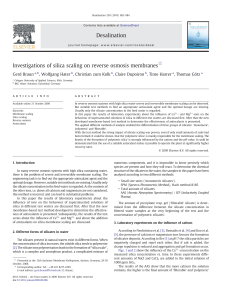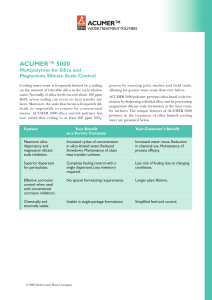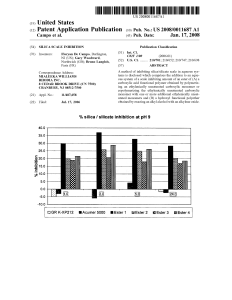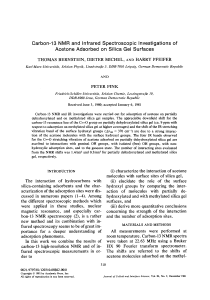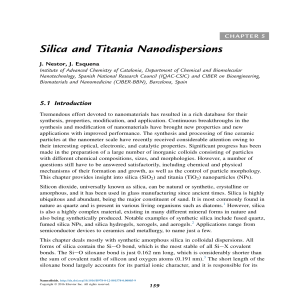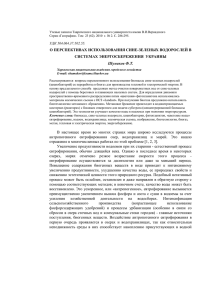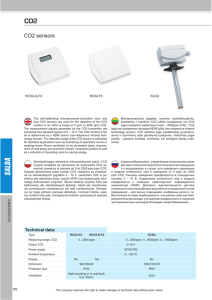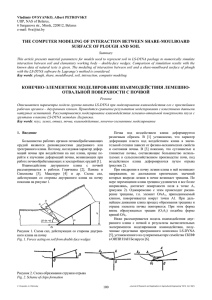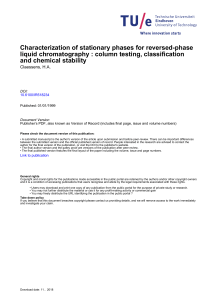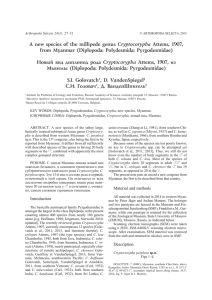
w a t e r r e s e a r c h 5 6 ( 2 0 1 4 ) 2 2 5 e2 3 3 Available online at www.sciencedirect.com ScienceDirect journal homepage: www.elsevier.com/locate/watres Star-shaped polymers of bio-inspired algae core and poly(acrylamide) and poly(acrylic acid) as arms in dissolution of silica/silicate Kalpana Chauhan a,*, Priyanka Patiyal a, Ghanshyam S. Chauhan b, Praveen Sharma c a Department of Chemistry, Shoolini University, Solan 173229, India Department of Chemistry, Himachal Pradesh University, Shimla 171005, India c Himachal Pradesh State Pollution Control Board, Shimla 171009, India b article info abstract Article history: Silica, in natural waters (due to weathering of rocks) decreases system performance in Received 3 June 2013 water processing industry due to scaling. In view of that, the present work involves the Received in revised form synthesis of novel green star shaped additives of algae core (a bio-inspired material as 28 December 2013 diatom maintains silicic acid equilibrium in sea water) as silica polymerization inhibitors. Accepted 5 March 2014 Star shaped materials with bio-inspired core and poly(acrylamide) [poly(AAm)] and poly(- Available online 16 March 2014 acrylic acid) [poly(AAc)] arms were synthesized by economical green approach. The pro- Keywords: and APAAc (Algae-g-poly(AAc)) dendrimers (star shaped) in colloidal silica mitigation/in- Silica inhibition hibition at 35 C and 55 C. Synthesized dendrimers were equally proficient in silica inhi- ficiency was evaluated in ‘mini lab’ scale for the synthesized APAAm (Algae-g-poly(AAm)) Green dendrimers bition at 12 h and maintains 450 ppm soluble silica. However, APAAm dendrimers of Algae generation 0 confirmed better results (z300 ppm) in contrast to APAAc dendrimers in silica Heterogeneous inhibition at 55 C. Additionally, dendrimers also worked as a nucleator for heterogeneous polymerization to inhibit silica homo-polymerization. APAAm dendrimer test set showed no silica deposit for more than 10 days of inhibition. EDX characterization results support nucleator mechanism with Si content of 6.97%e10.98% by weight in silica deposits (SiO2-APAAm dendrimer composites). ª 2014 Elsevier Ltd. All rights reserved. 1. Introduction Silicon is the second most abundant element (as silicate minerals) in the earth’s crust. Natural weathering process of silicate minerals increases silica/silicates concentration in natural water. Moreover, water resource conservation and environmental concerns have forced water processing industry to reuse “spent” water. But, efficient reuse of water in water processing industry is limited due to the low solubility of silica (30e120 mg/L) (Sheikholeslami and Bright, 2002). Silica in super-saturated concentration (120 mg/L) results hard and persistent deposits, which is a major operational obstacle for industrial processes (Neofotistou * Corresponding author. Tel.: þ91 9459368088; fax: þ91 01792226364/308000. E-mail address: kalpana13chauhan@gmail.com (K. Chauhan). http://dx.doi.org/10.1016/j.watres.2014.03.009 0043-1354/ª 2014 Elsevier Ltd. All rights reserved. 226 w a t e r r e s e a r c h 5 6 ( 2 0 1 4 ) 2 2 5 e2 3 3 Fig. 1 e Proposed structure for APAAm dendrimer. and Demadis, 2004; Javaherdashti, 2000). Silica polymer, an amorphous compound once formed is very difficult to remove because conventional anionic inhibitors are not sufficiently proficient to prevent silica polymerization. Conventional technologies (filtration and chemical precipitation) have been reported moderately successful in silica mitigation (Sheikholeslami and Bright, 2002; Mavredaki et al., 2007; Ueda et al., 2003; Greenlee et al., 2010). In therapeutic approach, chemical cleaning for silica deposits is a corrosive technique which can pose health hazards and environmental concerns (Demadis et al., 2012). However, in protective measures the additives (anionic, non-ionic and cationic) have been reported of potential in silica polymerization inhibition (Demadis et al., 2011; Roussy et al., 2005). The potential commercial silica inhibitors have primary and secondary amine as a structural unit (Demadis and Stathoulopoulou, 2006). Polyaminoamido STARBURST dendrimers (PAMAM) have also been reported proficient for silica inhibition, but the efficiency is in synergism with anionic polyelectrolytes (Mavredaki et al., 2005; Zhang et al., 2012). Moreover, commercial additives in silica mitigation, costs high and have an environmental concern (Demadis et al., 2005; Stathoulopoulou and Demadis, 2008). In view of that, there is an utmost need for an efficient, green and cost effective alternative in silica mitigation. It is evident from the literature that dendrimers with amine and amide functional groups are useful additives for silica polymerization mitigation. Knowledge of proficient commercial additive structures can be used as a guide for the synthesis of novel environmental friendly alternatives in silica inhibition (Lowenstam and Weiner, 1989). Algae, rich in amino acids can be exploited as a core for green bio-inspired material to mitigate silica polymerization (Brown et al., 1997; Falkowski and Raven, 1997; Wang and Brown, 2013). Moreover, algae (Diatom) have polyamine chains and phosphate groups, which maintains naturally silicic acid equilibrium (bio-mineralization) in the sea (Kroger et al., 2000). Algae biomass has already been extensively exploited as a commercial source for biofuels and polyphosphate accumulation (Aresta et al., 2005; Powell et al., 2009). But, the algae remnant (rich in protein) of the biofuels industry is a big challenge for disposal and utilization. Algae are generally microscopic organisms, which can act as an economical core for competent dendrites (Bhatanagar et al., 2002; Sigee, 2005). Demadis et al. (2009) have reported bioinspired control of colloidal silica, but in the presence of synthetic polymers. Furthermore, no previous works are reported in literature where waste protein rich biomass of algae was used as a core for dendrimers synthesis. In view of that, the aim of the present work is to design algae based promising new green dendrimers that are more efficient and cost-effective for homogeneous silicification inhibition. A suitable modification can enhance the desirable technological properties of the synthesized materials. In the present article, the algae based additives were synthesized via green protocol and evaluated as potential inhibitors for silica and silicates in simulated water solutions. 2. Experimental 2.1. Materials Sodium silicate (CDH, India), acrylic acid (AAc, CDH, India), acrylamide (AAm, CDH, India), ammonium molybdate (CDH, w a t e r r e s e a r c h 5 6 ( 2 0 1 4 ) 2 2 5 e2 3 3 227 Fig. 2 e a(i). Microscopic photo image for green algae, SEM result for a(ii) microalgae showing granular structure, a(iii) microalgae with fibril structure in insat (b) APAAm at (i) 1000 magnifications, (ii) 2000 magnification (c) APAAc at 2000 magnification. (For interpretation of the references to colour in this figure legend, the reader is referred to the web version of this article.) India), ammonium persulfate (APS, CDH, India), oxalic acid (CDH, India) and all other reagents were of analytical grade. The weights were taken on Denver Balance having minimum readability of 0.01 mg. 2.2. Microalgae modification Green microalgae were collected from nearby fresh water resource (Shown in Fig. 2a(i)). Micro-algae work as a core in the dendrimers synthesis because the cell wall of the same is difficult to disintegrate (Chen and Oswald, 1998). Microalgae were copolymerized with AAm and AAc in the molar ratio of 1:2 using APS as initiator (0.5% w/v), respectively. The resulting reaction mixture was stirred well to make it uniform and then kept undisturbed for 3 h at 65 C. Finally, the product was collected, washed with water and acetone for 30 min, separately and then dried at 50 C. The efficiency of the protocol was calculated as follows: %efficiency ¼ WS =WR 100 (1) 228 w a t e r r e s e a r c h 5 6 ( 2 0 1 4 ) 2 2 5 e2 3 3 Table 1 e EDX Results for APAAm and APAAc dendrimers. Algae Algae-g-poly (AAm) Algae-g-poly (AAc) Element Wt% N:C ratio Wt% N:C ratio Wt% N:C ratio CK NK OK 38.26 04.46 36.88 1:8.6 28.16 13.83 54.95 1:2.04 51.94 06.82 33.40 1:7.62 where WS is the weight of the synthesized product and WR is the weight of all reacting species including algae, AAm, APS and AAc, respectively. 2.3. Silicomolybdate spectrophotometric determination SiO2 solution (500 ppm) was prepared from Na2SiO3$5H2O in polyethylene containers to avoid silica leach out from borosilicate beakers. In control set, 200 ml of the SiO2 stock solution was placed in a plastic beaker. The pH of this solution was adjusted to 7.00 with HCl and NaOH. The beaker was covered with plastic membrane and set aside without stirring. Silica concentrations were checked at 12, 24, 48 and 72 h in the inhibition test sets. To the test solutions, the synthesized green inhibitors were also added to achieve desirable inhibitor concentration i.e., 20 ppm, 60 ppm and 80 ppm. Soluble silica measured by silicomolybdate method (Coradin et al., 2004). To the 20 ml of the sample solution, 2.0 ml ammonium molybdate (10% w/v, pH 7.0), 1.0 ml oxalic acid (7.0% w/v) and 1.0 ml HCl (6 M) were added in the sample tube. Reactive silica (soluble silica) reacts with ammonium molybdate to form silicomolybdate (a yellow colored compound). Oxalic acid is added to destroy any color interference from phosphate as molybdophosphoric acid. The solution was mixed well after addition of 2.0 ml oxalic acid solution. The solution was kept as such for 2 min. The spectrophotometer (Systronics 117 UVevis spectrophotometer) was set at a zero absorbance with water as the blank. Finally, the sample absorbance was measured at 452 nm. The standard curve was generated to calculate the unknown concentration of SiO2. 2.4. Characterization The synthesized green inhibitors were characterized for dendrimer structure by FTIR and SEM-EDX studies. FTIR was taken on a Perkin Elmer using KBr pellets. The morphology of the synthesized dendrimer and silica deposits was examined through SEM-EDX studies using Joel JSM 6100. 3. Results and discussion 3.1. Microalga dendrimers APS, a free radical initiator generates reactive sites on the surface of the microalgae core, which has carbohydrate as main constituents (Cronshaw and Preston, 1958). The reactive sites on microalgae cell wall initiate radical sites on AAm or AAc (reactive functionality) and thus lead to the multivalent functionalized products, respectively (Chauhan et al., 2012). Poly(AAm) or poly(AAc) chains protrude from algae cell wall as arms and provides the star like structure to the synthesized APAAm-0G (Algae-g-poly(AAm)-0 generation) and APAAc-0G (Algae-g-poly(AAc)-0 generation) dendrimers (Zhang et al., 2012). The resultant star shaped graft copolymer can be presented as depicted in Fig. 1. 3.2. SEM-EDX characterization Table 1 shows results for the elemental analysis. The weight% ratio of nitrogen (N) to carbon (C) in the fresh water green microalgae is 1:8.6. Elser et al. (2000) have reported almost same results elsewhere. Furthermore, algae grafting reactions to APAAm dendrimer structure results increase in the nitrogen to carbon wt% ratio i.e., 1:2.04, which is closer to AAm monomer unit (1:3). The results can be accounted for more poly(AAm) modification of algae surface, which results star like structure or dendrimer of generation 0 for APAAm. The synthesized APAAc dendrimer (shorter chain length) also shows a smaller change in nitrogen to carbon ratio (1:7.62), which is due to the fast chain transfer in case of AAc acid. The results can be explained on the basis of reactivity ratio of the two monomer units, which causes the longer homopolymeric chains in case of AAm in contrast to AAc. Seymour and Carraher (1988) have reported 1.38 and 0.36 reactivity ratios for AAm and AAc, at 60 C, respectively. SEM images results of microalgae show an almost granular structure and layers of parallel microfibrils (Fig. 2a(ii and iii)). SEM results for APAAc and APAAm support the modification as the surface appears rough after grafting reaction (Fig. 2b and c). SEM results also support clearly the star like structure for APAAm at different magnifications (Fig. 2b(i) and (ii). Images show protruded chains or structure from the surface of microalgae. But, SEM results for APAAc show no such clear characteristic for dendrimers structure (Fig. 2c). In conclusion, the distinction in SEM results can be accounted for the difference in reactivity ratios and chain transfer reactions for AAc and AAm. Additionally, APAAc retains almost structure of algae, which is also supported by EDX results (Table 1). SEM results characterize the size for synthesized dendrimers, which ranges from 10 to 50 mm for APAAm in contrast to 1e20 mm for APAAc. 3.3. Silica inhibition The evaluation of synthesized dendrimers efficiency as a silica polymerization inhibitor was carried out at 500 ppm SiO2 and pH 7.0 (Sjoberg, 1997). Solution is supersaturated and has value greater than 2.0 (Supersaturated ¼ c/c*, where, c is the solution concentration and c* is the equilibrium saturation at room temperature). The silica inhibition results show the decreases in soluble silica concentration with time, even if synthesized dendrimers are present. Therefore, green additives can only retard or extend silica polymerization. Control set shows maximum decrease (202 ppm) in soluble silica concentration at 72 h and 35 C (Fig. 3). Test sets also confirm decrease in soluble SiO2 concentration with time. However, decrease is very small in 24 h of polymerization inhibition. In dosage dependent inhibitory activity, the three polymeric w a t e r r e s e a r c h 5 6 ( 2 0 1 4 ) 2 2 5 e2 3 3 229 Fig. 3 e a. Effect of structure on silica solubility at 35 C and 20 ppm. b. Effect of structure on silica solubility at 35 C and 60 ppm. c. Effect of structure on silica solubility at 35 C and 80 ppm. d. Effect of temperature on the solubility of silica with APAAm dendrimers at different concentration. inhibitors (algae, APAAm dendrimers and APAAc dendrimer) show better silica inhibition efficacy at higher concentrations (60 ppm and 80 ppm) (Fig. 3). APAAm dendrimer at 60 ppm dosage shows z71% inhibition in 72 h and retains 355 ppm soluble silica (Fig. 3c). APAAc shows highest inhibitory activity at 80 ppm and 12 h with 474 ppm reactive silica (95%) in contrast to 442.7 ppm (z89%) in APAAm (Fig. 3b). APAAm dendrimers of generation 0 shows preferential results in comparison to earlier cite of most efficient PAMAM-0G inhibitor (Zhang et al., 2012). Furthermore, silica inhibition efficiency (by dissolution) of APAAm (320 ppm) and APAAc (263.3 ppm) appears lower at 72 h, in contrast to microalgae (370 ppm) at 80 ppm dosage (Fig. 3a). The effect of temperature shows increase in silica polymerization tendency with temperature as concentration for soluble silica decreases with temperature (Fig. 3d). Same results for temperature effect are reported elsewhere by Bradley (1993). Control set shows more decrease in soluble silica (212 ppm) in 12 h and 55 C in contrast to 35 C (347.3 ppm), while the further decrease is slight to 166.6 ppm at 55 C in 72 h. APAAm, 20 ppm dosage retains 290 ppm (z60%) and 442.7 ppm soluble silica in 12 h at 55 C and 35 C, respectively. After 72 h, soluble silica level drops further and is almost identical to control set (187 ppm) at 55 C. Lower temperature retains higher soluble silica (290 ppm) till 72 h. Higher dosages of 60 ppm and 80 ppm, are more efficient in silica polymerization 230 w a t e r r e s e a r c h 5 6 ( 2 0 1 4 ) 2 2 5 e2 3 3 1981; Iler, 1979). Firstly, heterogeneous nucleation mechanism allows solubilisation of silica, which may not be accessible for detection by silicomolybdate test. Actually, silicomolybdic acid is a cage-like structure and can yield a yellow compound for characterization only with monomeric silicic acid (Coradin et al., 2004). The inhibitory interaction of dendrimers and silica can prevent the yellow complex formation for concentration detection. The results can be supported in the absence of silica fluffy deposits till 10 days of inhibition test. Inhibitors can disrupt silicate polymerization by distorting nucleophilic attack of silicate ions among themselves. Dendrimers can also react with silicic acid by nucleophilic substitution or condensation reaction with active hydrogen of dendrimers to inhibit silica polymerization (Ning, 2002). The highest potential of APAAm polymers in silica inhibition can be credited to the hydrogen bond association of eNHCOe group of polymer with silanol groups (Sengupta et al., 2005, 2006). 3.4. Fig. 4 e FTIR spectra of (a) algae (b) APAAm (c) APAAmsilica deposits. inhibition to retain 252 ppm and 300.4 ppm (z60%) of soluble silica at 55 C and 72 h, respectively. APAAm shows almost comparable results for soluble silica (320.4) at 35 C and 80 ppm. The commercially available dendrimers has also been reported to maintain 300 ppm soluble silica, but the results are in synergism with polyelectrolytes (Mavredaki et al., 2005). Polymerization of silicic acid in colloidal silica can occur in supersaturated silica solutions through SN2 nucleophilic mechanism between silicate ions or silicic acid (Zhang et al., 2012). The green additives from waste biomass act as interference with the silica polymerization reaction and potentiated the silica solubility limit by keeping silicic acid or oligomer silica dispersed for the extended period of time. APAAm and APAC dendrimers can associate with silicate ions or silica oligomers, thus preventing further polymerization. Furthermore, the lower soluble silica results can be credited to the nucleation mechanism of dendrimers to floc by condensation or nucleophilic substitution (Euvrard et al., 2007; Weres et al., FTIR characterization FTIR spectrum of microalgae shows characteristic peaks at 3350.3 cm1 (polymeric associated OeH broad intense stretching or overlie eNH2 stretchings), 2923.4 cm1 (eCH2 stretchings), 1654.8 cm1 (eC]O of peptide), 1560.3 and 1425.4 cm1 (eNH2 bendings) and 1050-1250 cm1 (eCOCe stretchings) (Fig. 4a). APAAm dendrimer shows additional broad and strong peak at 1662.2 cm1 due to C]O of amide (Fig. 4b). FTIR spectrum of APAAm also shows distinction in the values and intensity of characteristic peaks of microalgae, which can be accounted for modification approval. FTIR results also support silica inhibition in test sets. FTIR spectrum of SiO2 deposit shows characteristic IR adsorption signals for bending vibration, symmetrical and asymmetrical stretching vibrations of bridged SieOeSi bonds at 463.2 cme1, 879.9 cme1 and 1015.9 cme1, respectively (Fig. 4c) (Lin, 1997). The deposits also show broadening and shifting in eOH stretching (3322.9 cme1), due to interaction of dendrimers through eOH group with silica in silica inhibition. Additionally, FTIR spectrum of silica deposit also shows an additional weak sharp signal at 2494.7 cme1 for quaternized amine, which can be accounted for protonation and nucleophilic reactions of eNH2 group in dendrimers (DeTar and Novak, 1970). 3.5. SEM-EDX analysis of silica deposits SEM results for silica deposits in APAAm dendrimer inhibition test set at 20 ppm show almost continuous silica layer (Fig. 5a) in contrast to earlier “rougher” surface of the dendrimers (Fig. 2b). At 80 ppm, APAAm dendrimer shows much more pronounced tendency for silica compact aggregation (Fig. 5b and c). SEM result also shows diffusion of silica in the pore sites or in microfibril structure of the dendrimers at higher magnification. The diffusion of silica in pore sites confirms the higher efficiency of synthesized dendrimers in silica inhibition. Dendrimers are acting as nucleators for silica polymerization. The silica particles exhibit severe aggregation and form continuous films by further depositions on the surface of the dendrimers. SEM image of silica inhibition in real conditions (with APAAm) show biomorphs with hairy sphere w a t e r r e s e a r c h 5 6 ( 2 0 1 4 ) 2 2 5 e2 3 3 231 Fig. 5 e SEM image of APAAm-silica deposit at (a) 20 ppm (b) 80 ppm and 1000 magnifications (c) 80 ppm and 3000 magnifications (d) in real conditions at 80 ppm and 3000 magnifications. clusters composed of radially aligned crystals (Fig. 5d) (Kniep and Busch, 1996). EDX characterization results show high amounts of silica in silica deposits i.e., 10.98% and 6.97% by weight at 20 ppm and 80 ppm APAAm, respectively (Fig. 6). From the spectrum, it is clear that the precipitates consist essentially of silicon and oxygen. The synthesized dendrimers show the silica inhibition efficiency and acts as silica nucleators forming SiO2-algae composites, which are accountable through high Si content in deposits. Fig. 6 e EDX spectra for APAAm-silica deposits at (a) 20 ppm (b) 80 ppm. 232 4. w a t e r r e s e a r c h 5 6 ( 2 0 1 4 ) 2 2 5 e2 3 3 Conclusions The area of research on scale inhibitor chemistry is making new efforts for green alternate. This work exploited a mean to convert spent biomass of biofuels to value added products. APAAm dendrimers of generation 0 showed maximum silica inhibition efficiency and retains 300 ppm soluble silica by dissolution at 55 C, which is even superior to commercial dendrimers. APAAm showed preferential competence in contrast to PAMAM-0G inhibitor at 12 h, as the green additive retard silica polymerization and maintains more than 450 ppm silica solubility. Secondly, the observed polymerization time or induction time was more than 10 days with APAAm dendrimers as no flocs were observed in test set. EDX results of silica deposits support heterogeneous nucleator mechanism of APAAm dendrimers with high amounts of silica (6.97%e10.98%) by weight. In conclusion, the study has contributed significantly and attractively to the green replacement of commercial additives. Algae as a core in the synthesis of dendrimers have not been exploited yet. Moreover, the processing cost in conventional dendrimers is high and they are not green. references Aresta, M., Dibenedetto, A., Carone, M., Colonna, T., Fragale, C., 2005. Production of biodiesel from macroalgae by supercritical CO2 extraction and thermochemical liquefaction. Environ. Chem. Lett. 3, 136e139. Bhatanagar, M., Bhatanagar, A., Jha, S., 2002. Interactive biosorption by microalgal biomass as a tool for fluoride removal. Biotechnol. Lett. 24, 1079e1081. Bradley, R., 1993. Design considerations for reverse osmosis systems. In: Amjad, Z. (Ed.), Reverse Osmosis: Membrane Technology, Water Chemistry and Industrial Applications. Van Nostrand Reinhold, New York, pp. 104e138. Brown, M.R., Jeffrey, S.W., Volkman, J.K., Dunstan, G.A., 1997. Nutritional properties of microalgae for mariculture. Aquaculture 151, 315e331. Chauhan, K., Kumar, R., Kumar, M., Sharma, P., Chauhan, G.S., 2012. Modified pectin-based polymers as green antiscalants for calcium sulphate scale inhibition. Desalination 305, 31e37. Chen, P.H., Oswald, W.J., 1998. Thermochemical treatment for algal fermentation. Environ. Int. 24, 889e897. Coradin, T., Eglin, D., Livage, J., 2004. The silicomolybdic acid spectrophotometric method and its application to silicate/ biopolymer interaction studies. Spectroscopy 18, 567e576. Cronshaw, J., Preston, R.D., 1958. A re-examination of the fine structure of the walls of vesicles of the green algae Valoni. Proc. Royal Soc. Lond. Ser. B: Biol. Sci. 148, 137e148. Demadis, K.D., Neofotistou, E., Mavredaki, E., Tsiknakis, M., Sarigiannidou, E.M., Katarachia, S.D., 2005. Inorganic foulants in membrane systems: chemical control strategies and the contribution of “green” chemistry. Desalination 179, 281e295. Demadis, K.D., Mavredaki, E., Somara, M., 2011. Additive-driven dissolution enhancement of colloidal silica. 1. Basic principles and relevance to water treatment. Indus. Eng. Chem. Res. 50, 12587e12595. Demadis, K.D., Pachis, K., Ketsetzi, A., Stathoulopoulou, A., 2009. Bioinspired control of colloidal silica in vitro by dual polymeric assemblies of zwitter ionic phosphomethylated chitosan and polycations or polyanions. Adv. Colloid Interface Sci. 151, 33e48. Demadis, K.D., Somara, M., Mavredaki, E., 2012. Additive-driven dissolution enhancement of colloidal silica. 3. Fluorinecontaining additives. Indus. Eng. Chem. Res. 51, 2952e2962. Demadis, K.D., Stathoulopoulou, A., 2006. Solubility enhancement of silicate with polyamine/polyammonium cationic macromolecules: relevance to silica-laden process waters. Indus. Eng. Chem. Res. 45, 4436e4440. DeTar, D.-L.F., Novak, R.W., 1970. Carboxylic acid-amine equilibria in nonaqueous solvents. J. Am. Chem. Soc. 92 (5), 1361e1365. Elser, J.J., Fagan, W.F., Denno, R.F., Dobberfuhl, D.R., Folarin, A., Huberty, A., 2000. Nutritional constraints in terrestrial and freshwater food webs. Nature 408, 578e580. Euvrard, M., Hadi, L., Foissy, A., 2007. Influence of PPCA(phosphino-polycarboxylic acid) and DETPMP(diethylenetriaminepentamethylene-phosphonic acid) on silica fouling. Desalination 205, 114e123. Falkowski, P.G., Raven, J.A., 1997. Aquatic Photosynthesis. Blackwell Sci, Malden, Mass. Greenlee, L.F., Testa, F., Lawler, D.F., Freeman, B.D., Moulin, P., 2010. Effect of antiscalants on precipitation of an RO concentrate: metals precipitated and particle characteristics for several water compositions. Water Res. 44, 2672e2684. Iler, R.K., 1979. The Chemistry of Silica. Wiley-Interscience, New York. Javaherdashti, R., 2000. How corrosion affects industry and life. Anti-Corrosions Methods Mater. 47 (1), 30e34. Kniep, R., Busch, S., 1996. Biomimetic growth and self-assembly of fluorapatite aggregates by diffusion into denatured collagen matrices. Angew. Chem. Int. Ed. 35 (22), 2624e2626. Kroger, N., Deutzmann, R., Bergsdorf, C., Sumper, M., 2000. Proc. Natl. Acad. Sci. U S A 97, 14133e14138. Lin, S.-Y., 1997. Vibrational local modes of a-SiO2:H and variation of local modes in different local environments. J. Appl. Phys. 82 (12), 5976e5982. Lowenstam, H.A., Weiner, S., 1989. On Biomineralization. Oxford University Press, Oxford. Mavredaki, E., Neofotistou, E., Demadis, K.D., 2005. Inhibition and dissolution as dual mitigation approaches for colloidal silica fouling and deposition in process water systems: functional synergies. Indus. Eng. Chem. Res. 44, 7019e7026. Mavredaki, E., Stathoulopoulou, A., Neofotistou, E., Demadis, K.D., 2007. Environmentally benign chemical additives in the treatment and chemical cleaning of process water systems: implication for green chemical technology. Desalination 210, 257e265. Neofotistou, E., Demadis, K.D., 2004. Inhibitor and growth control of colloidal silica: designed chemical approaches. Mater. Perform. 43 (4), 38e42. Ning, R.Y., 2002. Discussion of silica speciation, fouling, control and maximum reduction. Desalination 151, 67e73. Powell, N., Shilton, A., Chisti, Y., Pratt, S., 2009. Towards a luxury uptake process via microalgae e defining the polyphosphate dynamics. Water Res. 43, 4207e4213. Roussy, J., Van Vooren, M., Dempsey, B.A., Guibal, E., 2005. Influence of chitosan characteristics on the coagulation and the flocculation of bentonite suspensions. Water Res. 39 (14), 3247e3258. Sengupta, R., Bandyopadhyay, A., Sabharwal, S., Chaki, T.K., Bhowmick, A.K., 2005. Polyamide-6,6/in situ silica hybrid nanocomposites by solegel technique: synthesis, characterization and properties. Polymer 46, 3343e3354. Sengupta, R., Sabharwal, S., Bhowmick, A.K., Chaki, T.K., 2006. Thermogravimetric studies on Polyamide-6,6 modified by w a t e r r e s e a r c h 5 6 ( 2 0 1 4 ) 2 2 5 e2 3 3 electron beam irradiation and by nanofillers. Polym. Degrad. Stab. 91, 1311e1318. Seymour, R.B., Carraher, C.E., 1988. Polymer Chemistry, second ed. Dekker, New York. Sheikholeslami, R., Bright, J., 2002. Silica and metals removal by pretreatment to prevent fouling of reverse osmosis membranes. Desalination 143, 255e267. Sigee, D.C., 2005. Freshwater Microbiology Biodiversity and Dynamic Interactions of Microorganisms in the Aquatic Environment. John Wiley & Sons Ltd, The Atrium, Southern Gate, Chichester, West Sussex PO19 8SQ, England. Sjoberg, S., 1997. Silica in aqueous environments. J. NonCrystalline Solids 196, 51e57. Stathoulopoulou, A., Demadis, K.D., 2008. Enhancement of silicate solubility by use of “green” additives: linking green 233 chemistry and chemical water treatment. Desalination 224, 223e230. Ueda, A., Kato, K., Mogi, K., Mroczek, E., Thain, I.A., 2003. Silica removal from Mokai, New Zealand, geothermal brine by treatment with lime and a cationic precipitant. Geothermics 32, 47e61. Wang, K., Brown, R.C., 2013. Catalytic pyrolysis of microalgae for production of aromatics and ammonia. Green. Chem. 15, 675e681. Weres, O., Yee, A., Taso, L., 1981. Kinetics of silica polymerization. J. Colloid Interface Sci. 84, 379e402. Zhang, B., Sun, P., Chen, F., Li, F., 2012. Synergistic inhibition effect of polyaminoamide dendrimers and polyepoxysuccinic acid on silica polymerization. Colloids Surf. Physicochem. Eng. Asp. 410, 159e169.
